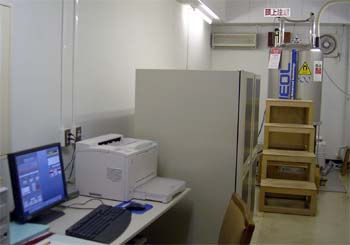|
|
 |
 |
|
 |
|
Supporting Research on the Synthesis of New Organic Molecules and Nano-Materials with Cutting-Edge Analysis Instruments |
 |
|
| |
Fourier Transform Nuclear Magnetic Resonance
Spectroscopy (FT-NMR)
|
|

JEOL ECA-500 (500MHz NMR)
Room 3
|

Varian INOVA 500 (500MHz NMR)
Varian INOVA 400 (400MHz NMR)
Room 4
|
Nuclear Magnetic Resonance (NMR) spectroscopy has become one of the most important tools for investigating the molecular structure and physicochemical properties of the matters in inorganic, organic and biological chemistry. The application of NMR in the medical field is also a current topic (e.g. tomogram by NMR).
NMR is a phenomenon which occurs when the nuclei of certain atoms, such as 1H and 13C, are immersed in a static magnetic field and exposed to a second oscillating magnetic field. Some nuclei experience this phenomenon, and others do not, dependent upon whether they possess a property called spin. NMR spectroscopy uses radiofrequency radiation to induce transitions between different nuclear spin states of samples in a magnetic field. The utility of this method for structural characterization arises because different atoms in a molecule experience slightly different magnetic fields and therefore transitions at slightly different resonance frequencies in an NMR spectrum. Furthermore, splittings of the spectra lines arise due to interactions between different nuclei, which provides information about the proximity of different atoms in a molecule.
The Center has three FT-NMR spectrometers.
1) JEOL ECA-500 (500 MHz) (Room 3)
This spectrometer is a ratest NMR in this center and equipped with autotuning probe. Therefore, it allows to mesure not only usual measurements (1H, 13C, multiple nuclei, DEPT, COSY, HMQC, HMBC etc.) but also all kinds of measurements such as 2D-measurements by use of Pulsed Field Gradients (PFG) technique.
2) Varian UNITY INOVA 500 (500 MHz) (Room 4)
This spectrometer allows to mesure not only usual measurements (1H, 13C, multiple nuclei, DEPT, COSY, etc.) but also all kinds of measurements such as 2D- and 3D-measurement and inverse measurement (HMBC, HMQC) by use of Pulsed Field Gradients (PFG) technique. The measurements at low temperatures to -60 C are available without liquid nitrogen.
3) Varian UNITY INOVA 400 (400 MHz) (Room 4)
This instrument is capable of measuring solid CP/MAS, and is employed auxiliary for INOVA 500. A limited amount of sample can be measured by use of a 'nano-probe'. |
| 2004.2.9 |
 |
|
 |
|



